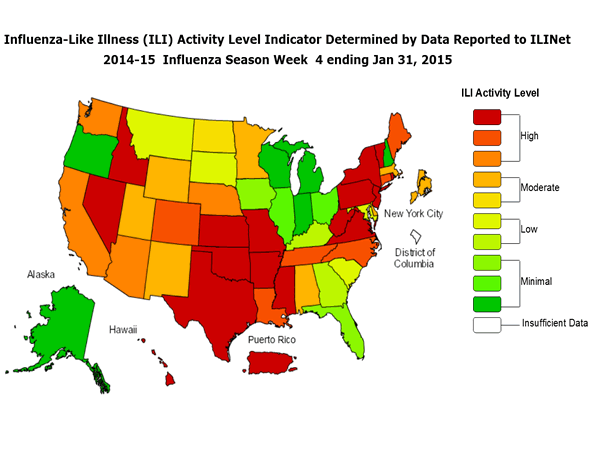Most measures of US influenza activity inched downward last week, but the rate of flu-related hospitalizations among elderly people is the highest in at least a decade, the Centers for Disease Control and Prevention (CDC) reported today.
While overall flu circulation remained high, medical visits for influenza-like illness (ILI), the number of states reporting high ILI activity, and the percentage of deaths attributed to pneumonia and flu all declined last week, the CDC reported.
But the agency said the cumulative flu-related hospitalization rate in people 65 years and older is 213.8 per 100,000, "which is the highest hospitalization rate recorded since data collection on laboratory-confirmed influenza-associated hospitalization in adults began during the 2005-2006 season."
The highest previous hospitalization rate in elderly people was 183.2 per 100,000 for the entire 2012-13 flu season, the CDC said. H3N2 viruses, which are associated with more severe epidemics, were predominant that winter, as they are this year.
The overall hospitalization rate has reached 43.5 per 100,000, up from 40.5 a week earlier, the CDC said. At this point in the 2012-13 season, the rate was 30.5 per 100,000. Hospital cases are counted by a surveillance network that covers parts of 13 states that account for about 9% of the US population.
Declining measures
The CDC said flu activity has been elevated for 11 straight weeks. An average flu season lasts 13 weeks, but this season could last longer because it started relatively early, officials said.
"Parts of the country that saw earlier increases in flu activity are now experiencing declines while regions where flu activity started later are still experiencing increases in activity," the agency said. A CDC map (below) shows that the highest activity is concentrated mostly in the south-central region, parts of the Northeast, Nevada, Idaho, Virginia, and West Virginia.

Among declining flu barometers, ILI accounted for 4.1% of outpatient clinic visits last week, which was down from 4.4% a week earlier but still well above the national baseline of 2.0%.
The CDC said 26 states and Puerto Rico reported high ILI activity, versus 29 states a week earlier. Flu was reported to be geographically widespread in 40 states, down from 44 states the week before.
The share of deaths attributed to pneumonia and flu was 8.5%, which was well above the epidemic threshold of 7.2% but down from 9.1% a week earlier.
Officials also cited a decrease in the percentage of respiratory samples that tested positive for flu: 17.5% of 22,122 samples, compared with 19.9% of 23,339 the previous week.
However, 8 flu-related deaths in children were reported last week, versus 5 a week earlier, raising the seasonal death toll in children to 69. Four of the fatal cases involved H3N2 viruses; viruses in the other four cases were not subtyped.
H3N2 hegemony holds
H3N2 viruses continued to be overwhelmingly predominant, the CDC said. Of the 3,869 positive respiratory samples, 91.4% of isolates were type A and 8.6% were type B. And among type A samples that were subtyped, 1,345 were H3 and just 5 were H1N1.
Since early in the season the CDC has been reporting that about two thirds of circulating H3N2 viruses that were analyzed differed from the H3N2 strain in the vaccine. That pattern continued with the latest findings, which show that 391 (68.7%) of the 569 H3N2 isolates tested so far do not match the vaccine strain.
See also:
Feb 6 CDC FluView update
Feb 6 CDC FluView summary





















